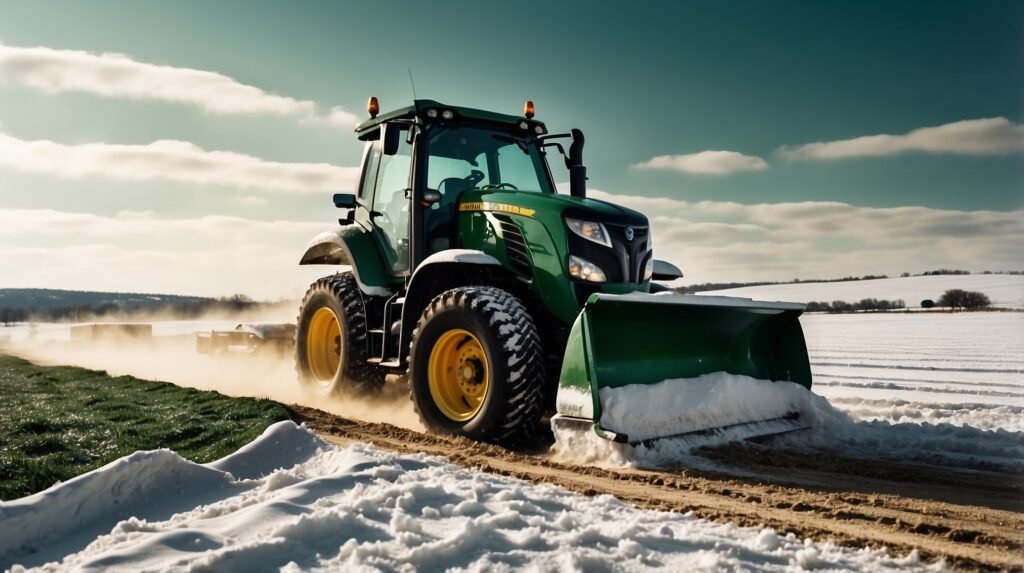Introduction
When winter’s white blanket covers the landscape, snow plowing becomes an essential service that ensures the safety and mobility of communities. The importance of snow plowing cannot be overstated; it is a critical activity that prevents accidents, facilitates emergency services, and keeps commerce flowing. But beyond the practicality, there is an art and science to effective snow removal that transforms this task into a skillful dance between man and machine, strategy and nature.
This blog post delves into the intricacies of snow plowing, offering expert insights into pre-season preparation, advanced techniques, and the latest equipment. Whether you’re a seasoned professional or just starting out, understanding the comprehensive approach to snow plowing can elevate your work from a mere job to a craft. Join us as we explore the mastery behind the art of snow plowing, ensuring that you’re ready to face the winter season with expertise and finesse.
Pre-Season Preparation
Before the first flake falls, successful snow plowing begins with meticulous pre-season preparation. Understanding your local weather patterns is crucial; it enables you to anticipate snow events and plan accordingly. This foresight not only improves response times but also ensures that you’re not caught off guard by sudden winter storms. Pre-season is also the time for thorough equipment maintenance and selection. Ensuring that plows, blowers, and spreaders are in top condition can mean the difference between a smooth operation and a breakdown in the heart of a blizzard.
Equally important is the implementation of training and safety protocols. Snow plowing can be hazardous, with icy conditions and low visibility. Providing comprehensive training for operators on the proper use of equipment and safety measures is paramount. This preparation safeguards not only the workers but also the public and the integrity of the property being serviced. A well-prepared team is an efficient and safe team, ready to tackle the winter season head-on.
Techniques and Strategies for Snow Plowing
Mastering snow plowing requires more than just pushing snow off the streets; it demands a strategic approach. Establishing a plowing route is the first step, ensuring that priority areas are cleared efficiently and effectively. High-traffic roads, emergency access routes, and public transit paths must be top of the list. Timing and frequency of plowing are also critical factors. Plowing too early or too infrequently can be as ineffective as not plowing at all, leading to dangerous build-ups of snow and ice.
Understanding the various plowing patterns and techniques is essential for dealing with different snow conditions. Whether it’s the light fluffiness of freshly fallen snow or the dense, compacted layers of old, each type requires a different approach. Operators must be adept at adjusting their methods to suit the situation, ensuring that roads and pathways are cleared to the best possible standard. This expertise is what elevates snow plowing from a mere task to an art form.
Advanced Snow Plowing Equipment
The evolution of snow plowing equipment has brought about innovations that enhance efficiency and effectiveness. Today’s machines are equipped with GPS tracking, advanced blade designs, and even environmentally friendly options. Staying abreast of these innovations not only improves the quality of service but also positions a plowing business as a leader in the industry. Customizing equipment for specific needs, such as fitting plows with rubber edges for delicate surfaces, further refines the plowing process and minimizes damage.
The role of de-icing agents in snow plowing cannot be understated. These materials, when used correctly, can prevent ice from bonding to the pavement and significantly reduce the amount of plowing needed. However, the choice and application of de-icing agents should be done thoughtfully, considering factors such as temperature, precipitation type, and environmental impact. The effective use of these agents is a testament to the sophistication and expertise required in modern snow plowing operations.
Environmental Considerations
As stewards of the environment, snow plowing professionals must consider the ecological impact of their work. Minimizing damage to the landscape and reducing the carbon footprint of operations is not only responsible but also increasingly demanded by clients and communities. Responsible use of chemicals and salt is a key aspect of this, as these substances can have detrimental effects on local ecosystems if overused or improperly applied.
Fortunately, alternative eco-friendly de-icing methods are emerging, offering a way to balance efficiency with environmental stewardship. These alternatives, such as brine solutions or beet juice mixtures, can reduce the reliance on traditional chemicals while still providing effective ice control. By adopting these methods, snow plowing professionals can lead the way in sustainable winter maintenance practices, ensuring that their work protects both the public and the planet.
Challenges in Snow Plowing
Every snow event brings its set of challenges, and managing large snow events can be particularly daunting. It requires coordination, resource management, and the ability to adapt to changing conditions. Navigating obstacles and hazards such as parked cars, hidden curbs, and low-hanging branches adds complexity to the task. Operators must be skilled in maneuvering around these impediments to avoid damage and ensure thorough clearing.
Addressing public expectations and communication is another significant challenge. Residents and businesses have high expectations for clear roads and sidewalks, and meeting these demands is essential for public satisfaction and safety. Effective communication about plowing schedules and service limitations can help manage these expectations and foster a cooperative relationship between the snow plowing service and the community it serves.
The Business of Snow Plowing
Turning snow plowing expertise into a thriving business involves more than just technical know-how. Building a clientele and marketing services are critical steps in establishing a successful operation. This includes identifying target markets, such as residential neighborhoods or commercial properties, and developing a marketing strategy that highlights the quality and reliability of your services. Pricing strategies also play a crucial role in the business of snow plowing. Setting competitive rates that reflect the value of the service provided while ensuring profitability is a delicate balance that requires careful consideration.
Legal considerations and insurance are aspects that cannot be overlooked. Snow plowing carries inherent risks, and having the right insurance coverage protects both the business and its clients. Understanding local regulations and ensuring compliance with them is also essential to operate legally and avoid potential liabilities. A well-managed snow plowing business is not only profitable but also operates with integrity and respect for the law.
Expert Insights
Gleaning knowledge from seasoned professionals can provide invaluable insights into the world of snow plowing. Interviews with veterans of the industry can reveal tips, tricks, and wisdom that only come with years of experience. These insights can help refine techniques, improve efficiency, and avoid common pitfalls. Case studies of unique snow plowing scenarios also serve as learning opportunities, showcasing innovative solutions to complex problems and highlighting the adaptability required in this line of work.
Reflecting on lessons learned from challenging plowing experiences is crucial for growth and improvement. Every winter season is different, and each presents an opportunity to learn and enhance one’s approach to snow plowing. By embracing these experiences and learning from them, professionals can continually elevate their expertise, ensuring that they are always at the forefront of the industry.
Conclusion
The pursuit of mastery in snow plowing is an ongoing journey that requires continuous learning and adaptation. As technologies evolve and new challenges arise, the need to stay informed and skilled becomes ever more critical. The importance of this craft extends beyond the practical; it is about providing a service that communities rely on for safety and normalcy during the harsh winter months.
For those who take pride in mastering the art of snow plowing, the satisfaction comes not just from a job well done, but from knowing that their expertise makes a real difference. It’s about more than moving snow; it’s about creating safe passages for daily life to continue, regardless of what the winter weather brings. With passion and dedication, the art of snow plowing is not just a necessary task—it’s a noble calling.
FAQs
What is the optimal time to begin snow plowing?
The optimal time to begin snow plowing varies depending on the snowfall rate and accumulation, but generally, it’s best to start when there’s a significant accumulation that hinders travel or poses safety risks.
How does heavy equipment impact the surface being plowed?
Heavy equipment can cause damage to surfaces if not used correctly. Using the right blade edges and ensuring proper equipment maintenance can minimize this impact.
Can snow plowing be environmentally friendly?
Yes, snow plowing can be environmentally friendly by using eco-friendly de-icing agents, optimizing routes to reduce fuel consumption, and responsibly managing the use of chemicals and salt.
What are the most common mistakes made by rookie plowers?
Rookie plowers often make mistakes such as underestimating the time needed for a job, not understanding the impact of different snow types, and failing to communicate effectively with clients.
How can one stay updated with the latest snow plowing techniques and equipment?
Staying updated with the latest snow plowing techniques and equipment can be achieved through industry publications, trade shows, continuing education, and networking with other professionals.

